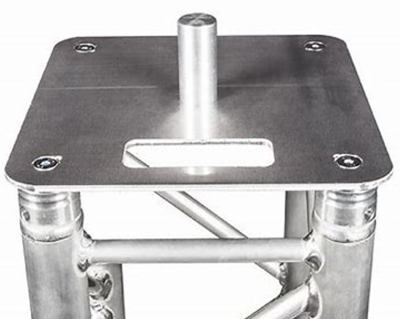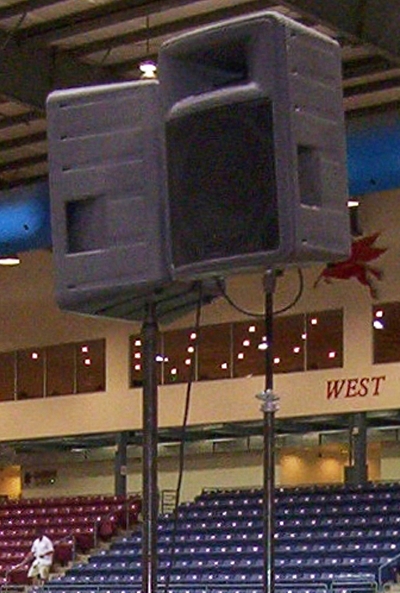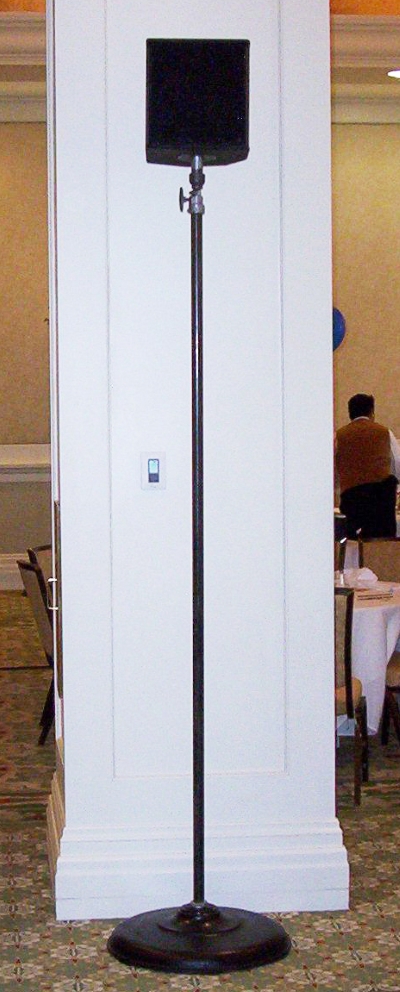
Wider Loads
Larger and/or wider coverage areas may call for additional loudspeakers pointed at areas not adequately covered by the mains. One time we served a graduation ceremony in a small arena where so many people showed up that school officials had to open up additional seating sections set off to the sides. We simply deployed more loudspeakers on stands, pointed at these additional coverage areas. Simple enough, and problem solved.
For extra-deep areas, loudspeakers that are time-delayed relative to the mains are often employed to extend coverage. Sound travels at about 1,128 feet per second (depending, of course, on temperature), so a good rule of thumb is to use 1 millisecond of delay for every foot the additional loudspeakers are placed from the mains.

Delays are often the right choice for corporate events because they eliminate the need for the mains to be played to loudly – the effort to extend coverage to the back can “blast out” the folks toward the front. Of course, multiple delays can be employed, just make sure that each one gets its own optimized delay setting so that output arrives time-aligned in relation to the mains.
Digital consoles make employing delays relatively easy because most have delay processing available on their outputs. In addition, many newer powered loudspeakers also include delay, making them simpler than ever to implement, even with analog mixers that lack onboard processing.
Another favorite option of mine is extra-tall stands that position the mains comfortably above the heads of standing audience members who may have to walk in front of a loudspeaker to get to their seats. This way, they aren’t deluged with sound.
Many loudspeaker pole sockets and yoke brackets facilitate higher placement and then allow the loudspeaker to be tilted downward to optimize coverage along with keeping stray energy off the back wall where it can “slap back” into the audience.
Reaching Higher
Standard tripod stands may not get cabinets high enough in the air. One common solution being a Truss Totem, which is a section of truss standing upright and bolted to a wide, heavy base (normally about 2 to 3 feet square) for added stability. Sandbags can also be placed atop the base for even further stability.

From there, a spigot is attached to a top plate on the truss, and the loudspeaker is secured atop the spigot using its stand socket. A Truss Sock (a stretchy, Spandex-type sleeve) is sometimes placed over the truss to disguise it, or a light called a Truss Warmer might be placed inside the truss to accent the aesthetic.
Crank towers are another way to get loudspeakers higher in the air. Sometimes a crossbar is added to a truss totem or crank stand, with the loudspeakers flown from the bar. Note: Make sure to have a qualified person design and certify as safe any rigging where a loudspeaker is flown.
My company’s preferred solution for getting more height is the use of standard 50-pound lighting boom bases and 1.5-inch pipes topped by 1-inch reducers that will fit inside most loudspeaker stand sockets. A wrap of gaff tape around the 1-inch reducer section makes for a snug fit with standard sockets.

For tall, top-heavy systems, we place sandbags on the bases for added stability and then drape them with a piece of fabric for a clean, professional appearance. We’ve also designed a few adjustable poles to quickly and easily position loudspeakers at any height that might be needed.
Yet another configuration, often employed at races, airshows, and other large gatherings, is a row of loudspeakers on sticks spaced equidistantly across the front of the audience area. These loudspeakers aren’t usually on individual delays.
This approach can work well, but caution is advised – locating the loudspeakers too far apart will lead to gaps in the coverage. The key is using enough loudspeakers and positioning them so that every the entire area is in the coverage pattern of at least a single or a pair of loudspeakers.
Additional Apps
“Speakers on sticks” also come in handy in monitor applications. We often deploy compact loudspeaker/sub tandems as side fills on stage.
Last year, a DJ at a corporate event requested a set of “Texas Headphones,” a.k.a., large loudspeakers pointed at him for monitoring. While some gigs of this type larger loudspeakers, and even smaller line arrays, we’ve found that a pair of 15-inch 2-way loudspeakers do the trick.
At many corporate events, backstage techs like video, lighting, teleprompter crew and client personnel need/want to hear the program material, so we also make sure to have enough speakers on sticks on hand to fulfill these needs and requests.
Finally, sometimes we’re also forced to put front of house in a less-than-ideal location, such as behind the main PA. In these situations, a speaker on a stick pointed back at the house console, with volume adjusted to need/taste, comes in very handy in helping us to get enough sonic input to optimally mix the event.
